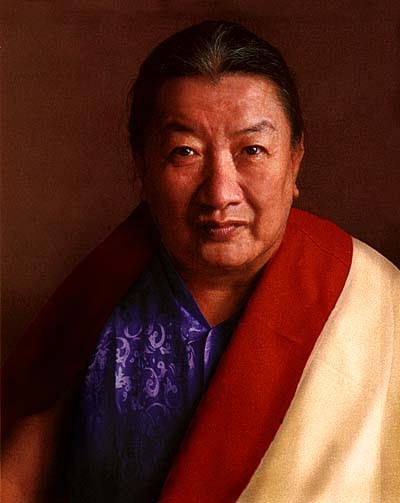
Kyabjé Minling Trichen Rinpoche
Head of the Nyingma Tradition
Ngak’chang Rinpoche visited Kyabjé Minling Trichen in 1979 and, on being granted an audience, requested information regarding his life. The following account has been edited from a lengthier transcription.
Before I became
eight years old, I went to live in the heavily forested area of Kham Lumo-ra
with my parents. I lived a free and happy life there, but when my father passed
away, my family went back up to central Tibet – and that is when I began my
formal studies at Mindröl Ling. I started with Tantric studies – reading from the
Pema Kathang. Later I had to memorise the three sets of Mindröl Ling
gTérma texts. I had
to recite these texts by heart in front of the general assembly of Mindröl Ling.
This was followed by the studies of ritual texts of the oral (bKha’ brGyud)
tradition.
When Khen Rinpoche came from Kham, I studied the Rinchen Themké Ngöndro (Rin
chen Them sKas sNgon ’gro) as well as chanting, gar’cham (sGar
’cham – Tantric dance), calligraphy, poetry, and
grammar. When I was eighteen, I entered a four-year retreat, and during that retreat I completed
the meditational practices of the Ka’gyüd (bKa’ brGyud), Phurba and Sang-thig
(gSang thig) Secret Essence. My family line is called the Nyo (gNyos) lineage. It began with a
being who descended from the sky to the summit of Kharag. He met a girl from the region around
Kharag and together they had a son. There have been thirteen generations from gTérdag
Lingpa (gTér gDag gLing pa – the incarnation of Vairochana) down to myself. There are
two aspects of this line – the ‘bone line’ which is male and the ‘blood
line’ which is female. The Bone Nyo Lineage continued up until Tri Yeshé Wangyal
(Khrid Ye shes dBang rGyal). He had nine daughters but no sons, so the Bone Nyo Lineage died out.
After Tri Yeshé Wangyal, Tri Déchen Chogdrup (Khrid bDe chen mChog grub) had one
son, but he passed away when he was but young. Since then we have not had the Bone Lineage of Nyo
Trichens (sNyo khri chen – Great Throne Holders). The next reincarnation of gTérdag
Lingpa was called gTérchen Rangrig, and he was referred to as Kusum Sangdag Lingpa (sKu
gSum gSang gDag gLing pa). At present there is no Bone Lineage of Nyo, but the Blood Lineage
continues.
It is a lineage of gTértöns, and amongst their revelations are the divisions of
Sa gTér (earth revelations), Gong gTér (mind revelations), and many others. From
gTérdag Lingpa onwards, the lineage mainly consisted of those who revealed Sa gTér.
Kusum Sangdag Lingpa for example revealed many Sa gTér, but there have not been many
revealers of Gong gTér.
Today in Clementown—Dehra Dun—we practise mainly the La-dzog Thug-sum, which
consists of the Lama’s Accomplishments (bLa sGrub), the La-drüp Rig’dzin Thugthig
(bLa sGrub rig ’dzin thugs thig), and Guru Drakmar Drüpthab (gu ru drag dMar sGrub
thabs).
The La-dzog comprises of the three unique practices of gTérdag Lingpa: the Dorje Sempa (rDo
rJe sems dPa) practices, the Thugjé Chenpo Désheg Kun’du (thugs rJe chen po
bDe gShegs kun ’dus), and with regard to Dzogchen, we have Dzogchen Ati Zür-thig
Nyingpo (rDzogs chen a ti zur thig sNying po).
The collected literature of Mindröl Ling is called the Four New Treasures of
Mindröl Ling (sMin grol gLing gi gTér gSar bZhi). There is no Mindröl Ling
tradition which is not included in these four treasures. The four texts are extensive – for
example the Thugjé Chenpo Desheg Kundu comprises of three volumes. Dzogchen Ati Zuthig
Nyingpo is also one entire volume.
There were maybe 111 gompas around the upper, lower and Gyé-ta regions – the
largest being Pombo-ra, Bu-chö, and Déchen Lhundrüp. Mindröl Ling itself was
a branch gompa. The original mother gompa was Dargyé Chöling, which was founded by the
father of gTérdag Lingpa, Sangdag Thin-lé Lhundrüp. It was built by Kunkhyen
rGan gog Ten’dzin. Shabdrung Rinpoche—my immediate younger brother—was head of
Pombo-ra Gompa in Kham. It was the seat of Kusum Sangdag Lingpa but since no one was chosen,
Shabdrung Rinpoche became the head Lama of Pombo-ra. Our father passed away, when I was very
young. Chung Rinpoche—my elder brother—was the throne holder of Mindröl Ling
until I reached adulthood. When Chung Rinpoche was out of the monastery Khen Rinpoche assumed the
rôle as the head of Pombo-ra. My brother Pé-nang Rinpoche was a Siddha whose
behaviour was like that of madman – and he could not be counted among ordinary
practitioners.
In the Nyo Lineage there have been a number of notable women practitioners. Jétsunma
Min’gyür Paldrön was a daughter of gTérdag Lingpa. She was the incarnation
of Khandro Yeshé Tsogyel.
Her next incarnation was Jétsunma Thrin-lé Chödrön. Her next incarnation
was Jétsunma Thrin-lé Wangmo – and we called her ‘White-haired Great
Aunt’. The great aunt we call ‘Black-haired Great Aunt’ was the mother of Khen
Rinpoche and Chung Rinpoche. When Mindröl Ling was destroyed by the Dzungar Mongols,
Jétsunma Min’gyür Paldrön repaired the buildings, and for this reason she
is
regarded as precious. Later Jétsunma Thrin-lé Chödrön restored it to its
original purity. Jétsunma Thrin-lé Chödrön’s disciple, the first
Khyentsé, also contributed greatly to restoring the Nyingma tradition.
The 16th Karmapa showed great kindness to my daughter Tséring. He gave
her the name Karma Ögyen Tsomo, which was the name of the
sangyum of the 15th Karmapa, and recognised her as the incarnation of that sangyum.
